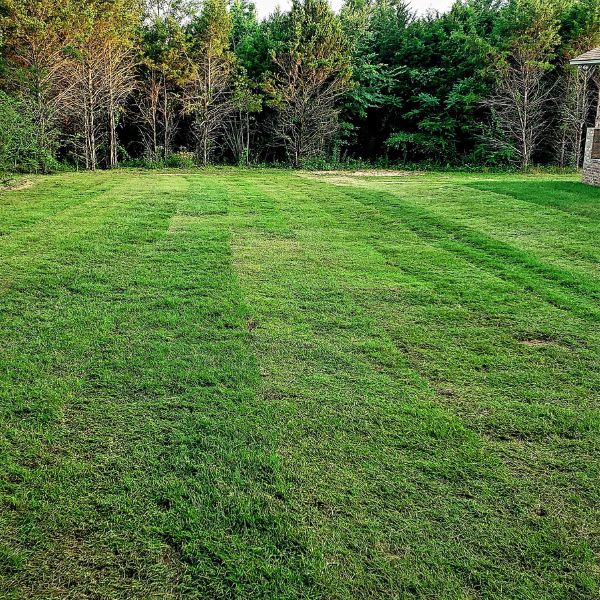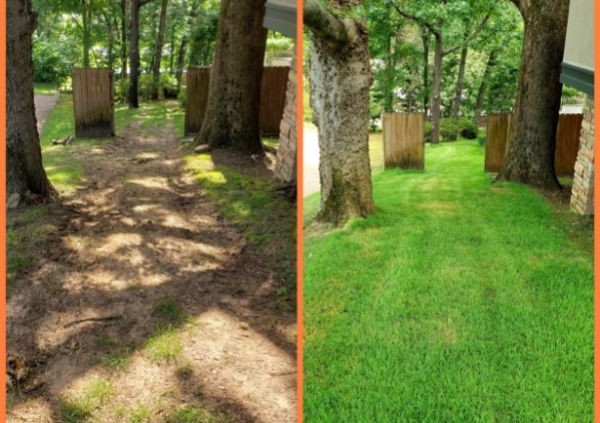How To Water Sod and Mow Sod After Installation (Official Guide)
Learn how to water sod and mow sod after installation by reading this in-depth how-to blog post from the sod experts at Riverview Turfworks in Fort Smith, AR.
All post-installation maintenance of sod is the client’s responsibility. We want to make sure you understand how to care for your sod to protect your investment in your lawn!
If you are located in the Arkansas River Valley or Northwest Arkansas, we’d love to provide you with an estimate for sod installation. Riverview Turfworks can help set up sprinklers during the installation if needed.

How To Water Newly Installed Sod (First 20 Days)
There is a lot to know if you want to water sod properly and protect your investment in your lawn. Please note that watering times will vary for every installation due to varying issues such as weather, sprinkler type, water pressure/flow, soil type, property characteristics, shade coverage, etc. It is the client’s responsibility to water properly.
The #1 rule for new sod watering is to make sure the soil underneath the sod and the sod roots are moist; this is what your watering times will be based on. With that being said there are some compromises; for instance, the soil/sod will be muddy right after watering, and dryer just before the sprinklers start again. We DO NOT want the soil muddy all day long, nor do we want it dry all day long. In an ideal environment, the soil/sod will be moist 24/7. To check how wet the soil/sod is simply lift a corner of the sod in several places throughout the installation.

Additional Sod Watering Tips
Yes, rain affects how much and how often you need to water sod. If you are receiving rain be sure to adjust your watering schedule accordingly.
Do not water at night (2 hours before dark – 4 am) unless the sod is extremely dry. Soggy grass at night causes disease and mildew to grow.
At the time of the first watering, if the soil is dry (think summer time, or droughts) then the first few waterings will need to be longer than normal so that the soil can absorb all of the water; you may need to double or triple watering times. It is ideal for your soil to be moist 4”-6” deep.
The first couple of days you will likely be dialing in the time your sprinklers are on, be sure to check the sod BEFORE your next sprinkler cycle starts, as well as IMMEDIATELY AFTER your sprinklers stop – Adjust your sprinkler timer as needed. For your first watering try setting your sprinklers to 20 minutes and test the results using the #1 Rule listed above. Some situations will need sprinklers running as long as 40 minutes per watering, do not be scared to lower or increase your watering time.
Temperatures over 85 degrees Fahrenheit during the day we recommend watering 3x daily for the first 10 days, and 2x daily for days 11-20. When you switch to 2x daily you will need to up the watering times by about 25% each. Hotter temperatures and more sunshine mean your sod will dry out quicker. Set your sprinkler timers to 7 am, 1 pm, and 6 pm for your watering times when doing 3x daily – and 10 am/6 pm when doing 2x daily. If you have multiple zones needing to be watered, do the math and adjust the last watering time accordingly so that you are not watering any later than 2hours before sundown. Always refer to Rule #1 listed above to adjust your watering schedule.
Temperatures 65-85 degrees Fahrenheit during the day. We recommend watering 2x daily during the first 10 days after installation and 1x daily for days 11-20. Set your sprinkler timers to 6 am and 2 pm when doing 2x daily, and 1 pm when doing 1x daily. Always refer to Rule #1 listed above to adjust your watering schedule.
Temperatures 40-65 degrees Fahrenheit during the day. We recommend watering 1x daily, or less. Set your sprinkler timers to 7 am. Temperatures closer to 65 degrees Fahrenheit will need 1x daily watering, while cooler temperatures may be able to go 1x every other day or 1x every 3 days. Always refer to Rule #1 listed above to adjust your watering schedule.
Watering Newly Established Sod (21 Days After Installation – 6 Months)
The first 8 weeks of your sod installation are crucial to the development of the root system.
When temperatures are over 65 degrees Fahrenheit be sure to water sod 2x per week (in times of extreme heat/drought every other day may be necessary), temperatures 40-65 degrees Fahrenheit 1x every 7-10 days are good. At this time longer water periods are preferred to short watering periods because your grassroots need to grow deep in order to flourish. The roots will grow towards the moist soil; a short watering time will only soak into the top inch or two of soil causing shallow roots, this is why you need longer watering times to allow the soil to be moist 4”+ which will cause the roots to grow deep.
Fully Established Lawn Watering Guidelines
Your lawn needs 1” of water per week. When temperatures are over 90 degrees Fahrenheit up your watering to 2” per week.
The time your grass is watered doesn’t matter too much, other than you do not want your lawn to be wet at night. Generally, we recommend watering between 6 am-noon.

How To Mow Newly Installed Sod
Mowing practices will vary depending on terrain and temperature. Wait at least 5 days after the sod has taken root before mowing. To test if the sod has taken root you should be lifting the corners on various sod pieces daily, once there is resistance in lifting them then the roots are established. If your sod was installed on a hill you should wait 10 days after the sod takes root. Be careful when using riding mowers to not spin the tires or make too tight of turns, this will harm the roots.
Use your best judgment to not damage the roots/sod while mowing, if there is an area you do not think you can mow safely then use a weedeater or push mower. Chances are that the sod is a little overgrown for the first mowing, raise the deck on your mower as high as it will go for the first mowing. Do not mow at a height lower than 3” for the first 8 weeks.
Other than the first mowing service, do not cut more than 1/3 of the grass blade off during each mowing service. This means if the grass is 6” tall do not cut it lower than 4”. If temperatures are above 85 degrees Fahrenheit then your Bermuda/zoysia sod should be growing quickly, you’ll likely need to mow it every 4-6 days during the first few weeks to keep from cutting more than 1/3 of the grass blade.
Mowing Established Lawns
Mowing is the most important part of your lawn’s health. You’re able to curb drought, burn-out, and weeds by mowing the proper height and frequency. For lawns in the River Valley/Northwest Arkansas area that typically means mowing every week for most of the year, and bi-weekly during early spring and late fall.
Your mowing height will depend on your mowing frequency and the weather. Do Not cut more than 1/3 of the grass blade off when mowing, doing this repetitively will damage the grass to the point of killing it. Bermuda and Zoysia are our two most popular types of grass and are both warm-season grasses, this means they flourish when temperatures are above 85 degrees Fahrenheit – aka they grow fastest during the summer.
A freshly fertilized and properly watered Bermuda yard will grow 3” per week during the summer. The point being made here is that our grasses have a faster/slower growing period. If you keep the same mowing frequency all season then you will need to adjust your cut height accordingly to the temperatures; if you want to keep the same cut height all year long then you will have to adjust your mowing frequency according to the temperature.
Riverview Turfworks also offers weekly lawn mowing services, so we adjust the mowing height to the particular season we are in. Typically we will start the first spring service cutting at 3”, this is because our last fall service is cut at 3” and the grass will grow slowly over the winter. Otherwise, our early spring mowing services are cut at 2.5” for the most part.
As temperatures start to rise we raise the cut height gradually, when temperatures get around 80 degrees Fahrenheit we will be mowing at 3”. When summer hits and temperatures are over 90 degrees Fahrenheit we will be mowing at 3.5”. If we receive constant temperatures (or a drought) over 95 degrees Fahrenheit we will raise the mowing height one final time to 4”. Raising the height mostly serves to curb the amount of grass blade height being cut off every week to 1/3 or less, however during the summer the longer blades also provide insulation and shade from the sun to help retain soil/root moisture.
As temperatures lower during the fall we end the season at 3”. Just as longer grass blades help insulate from the heat during the summer, they also help insulate the roots from extreme cold during the winter.
Conclusion: How To Water Sod and Care For Sod After Installation
We hope you found value in this detailed information about how to water sod by the Zoysia and Bermuda sod installation experts at Riverview Turfworks.
If you are located in the Arkansas River Valley near Fort Smith or in Northwest Arkansas please feel free to request your free quote for sod installation.




Leave a Reply
Want to join the discussion?Feel free to contribute!